船载航行数据记录仪(VDR)详解ppt课件
VDR 船舶黑匣子
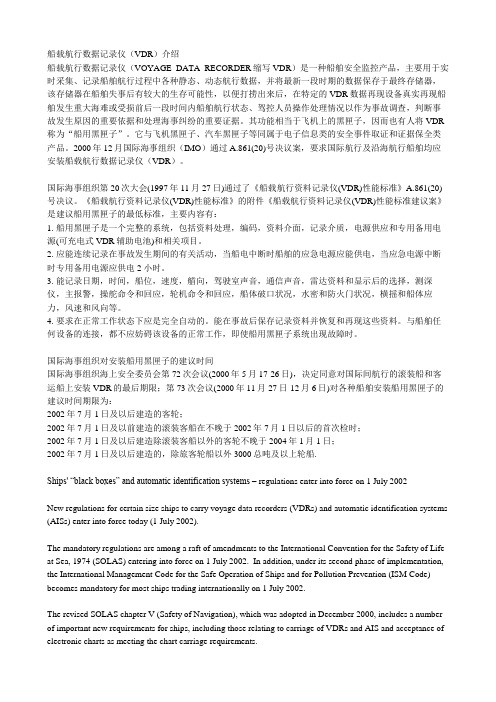
船载航行数据记录仪(VDR)介绍船载航行数据记录仪(VOYAGE DATA RECORDER缩写VDR)是一种船舶安全监控产品,主要用于实时采集、记录船舶航行过程中各种静态、动态航行数据,并将最新一段时期的数据保存于最终存储器,该存储器在船舶失事后有较大的生存可能性,以便打捞出来后,在特定的VDR数据再现设备真实再现船舶发生重大海难或受损前后一段时间内船舶航行状态、驾控人员操作处理情况以作为事故调查,判断事故发生原因的重要依据和处理海事纠纷的重要证据。
其功能相当于飞机上的黑匣子,因而也有人将VDR 称为“船用黑匣子”。
它与飞机黑匣子、汽车黑匣子等同属于电子信息类的安全事件取证和证据保全类产品。
2000年12月国际海事组织(IMO)通过A.861(20)号决议案,要求国际航行及沿海航行船舶均应安装船载航行数据记录仪(VDR)。
国际海事组织第20次大会(1997年11月27日)通过了《船载航行资料记录仪(VDR)性能标准》A.861(20)号决议。
《船载航行资料记录仪(VDR)性能标准》的附件《船载航行资料记录仪(VDR)性能标准建议案》是建议船用黑匣子的最低标准,主要内容有:1. 船用黑匣子是一个完整的系统,包括资料处理,编码,资料介面,记录介质,电源供应和专用备用电源(可充电式VDR辅助电池)和相关项目。
2. 应能连续记录在事故发生期间的有关活动,当船电中断时船舶的应急电源应能供电,当应急电源中断时专用备用电源应供电2 小时。
3. 能记录日期,时间,船位,速度,艏向,驾驶室声音,通信声音,雷达资料和显示后的选择,测深仪,主报警,操舵命令和回应,轮机命令和回应,船体破口状况,水密和防火门状况,横摇和船体应力,风速和风向等。
4. 要求在正常工作状态下应是完全自动的。
能在事故后保存记录资料并恢复和再现这些资料。
与船舶任何设备的连接,都不应妨碍该设备的正常工作,即使船用黑匣子系统出现故障时。
国际海事组织对安装船用黑匣子的建议时间国际海事组织海上安全委员会第72次会议(2000年5月17-26日),决定同意对国际间航行的滚装船和客运船上安装VDR的最后期限;第73次会议(2000年11月27日-12月6日)对各种船舶安装船用黑匣子的建议时间期限为:2002年7月1日及以后建造的客轮;2002年7月1日及以前建造的滚装客船在不晚于2002年7月1日以后的首次检时;2002年7月1日及以后建造除滚装客船以外的客轮不晚于2004年1月1日;2002年7月1日及以后建造的,除旅客轮船以外3000总吨及以上轮船.Ships' “black boxes” and automatic identification systems – regulations enter into force on 1 July 2002New regulations for certain size ships to carry voyage data recorders (VDRs) and automatic identification systems (AISs) enter into force today (1 July 2002).The mandatory regulations are among a raft of amendments to the International Convention for the Safety of Life at Sea, 1974 (SOLAS) entering into force on 1 July 2002. In addition, under its second phase of implementation, the International Management Code for the Safe Operation of Ships and for Pollution Prevention (ISM Code) becomes mandatory for most ships trading internationally on 1 July 2002.The revised SOLAS chapter V (Safety of Navigation), which was adopted in December 2000, includes a number of important new requirements for ships, including those relating to carriage of VDRs and AIS and acceptance of electronic charts as meeting the chart carriage requirements.Voyage data recordersLike the black boxes carried on aircraft, VDRs enable accident investigators to review procedures and instructions in the moments before an incident and help to identify the cause of any accident. Performance standards for VDRs were adopted by IMO in 1997 (IMO resolution A.861(20)) and IMO encourages all ships to carry VDRs.In addition, IMO’s Maritime Safety Committee (MSC) in May 2002 approved MSC/Circ.1024 on Guidelines on Voyage Data Recorders (VDR) ownership to complement the VDR performance standards.VDR requirementsThe following ships are required to carry VDRs, under regulation 20 of the new SOLAS Chapter V:passenger ships constructed on or after 1 July 2002;ro-ro passenger ships constructed before 1 July 2002 not later than the first survey on or after 1 July 2002; passenger ships other than ro-ro passenger ships constructed before 1 July 2002 not later than 1 January 2004; and ships, other than passenger ships, of 3,000 gross tonnage and upwards constructed on or after 1 July 2002.VDRs are required to meet performance standards “not inferior to those adopted by the Organization”. Performance standards for VDRs were adopted in 1997 and give details on data to be recorded and VDR specifications. They state that the VDR should continuously maintain sequential records of preselected data items relating to status and output of the ship's equipment and command and control of the ship. The VDR should be installed in a protective capsule (太空舱) that is brightly coloured and fitted with an appropriate device to aid location. It should be entirely automatic in normal operation. Under the new regulation, the voyage data recorder system, including all sensors, shall be subjected to an annual performance test conducted by an approved testing or servicing facility to verify the accuracy, duration and recoverability of the recorded data.Administrations may exempt ships, other than ro-ro passenger ships, constructed before 1 July 2002, from being fitted with a VDR where it can be demonstrated that interfacing a VDR with the existing equipment on the ship is unreasonable and impracticable.VDRs for existing cargo shipsIn December 2000, IMO’s Maritime Safety Committee (MSC) adopted a resolution on the carriage of VDRs on existing cargo ships, which calls for a feasibility study (可行性研究)to be carried out to ascertain the need for mandatory carriage of VDRs on these ships. The feasibility study, being conducted by the Sub-Committee on Safety of Navigation (and other Sub-Committees as appropriate), takes into account such factors as practicability, technical problems relating to the retrofitting (花样翻新)of VDRs, adequacy of existing performance standards including the possible development of simplified standards, experience in the use of VDRs on ships already fitted with them, including data that could not have been obtained without VDRs, and relevant financial implications, including a cost-benefit analysis.The aim is to finalize the study by 1 January 2004 so that, if the study demonstrates a compelling (强制的)need for mandatory carriage of VDRs on existing cargo ships, relevant amendments to SOLAS Chapter V and the associated performance standards can be drafted. In the meantime, the resolution invites Governments toencourage shipowners to install VDRs on existing cargo ships voluntarily, so that wide experience of their use may be gained.IMO GUIDELINES ON VOYAGE DATA RECORDERS (VDR) OWNERSHIP AND RECOVERY1.) Ownership of VDR/data:The ship owner will, in all circumstances and at all times, own the VDR and its data. however, in the event of an accident the following guidelines would apply.2.) Recovery of VDR:Recovery of the VDR is conditional on the accessibility of the VDR or the data contained therein.a.) In the case of a non-catastrophic (灾难的)accident, recovery of the memory should bestraightforward. For example, in some VDRs it can be accomplished by removal of a hard discfrom the VDR unit. This action will have to be taken soon after the accident to best preserve therelevant evidence for use by both the investigator and the ship owner. As the investigator is veryunlikely to be in a position to instigate this action soon enough after the accident, the owner mustbe responsible, through its on-board standing orders, for ensuring the timely preservation of thisevidence in this circumstance.b.) In the case of abandonment of a vessel during an emergency, masters should, where time andother responsibilities permit, recover the memory and remove it to a place of safety and preserveit until it can be passed to the investigator.c.) In the case of a catastrophic accident, where the VDR is inaccessible and the data has notbeen retrieved prior to abandonment, a decision will need to be taken by the Flag State in co-operation with any other substantially (充分的)interested States on the viability (生存能力)and cost of recovering the VDR balanced against the potential use of the information. If it isdecided to recover the VDR the investigator should be responsible for co-ordinating its recovery.The possibility of the capsule having sustained damage must be considered and specialistexpertise will be required to ensure the best chance of recovering and preserving the evidence. Inaddition the assistance and co-operation of the owners, insurers and the manufacturers of theVDR and those of the protective capsule may be required.3.) Custody (保管)of VDR/data:In all circumstances, during the course of an investigation, the investigator should have custody of the original VDR data, perhaps in the form of the whole or part(s) of the VDR itself, in the same way as if he has custody of other records or evidence under the Code for the Investigation of Marine Casualties and Incidents.4.) Read-out of VDR/data:In all circumstances the responsibility to arrange down loading and read-out of the data from the recovered memory in whatever form should, in the first instance, be undertaken by the investigator who should keep the shipowner fully informed. Additionally, specially in the case of a catastrophic accident where the memory may have sustained damage, the assistance of specialist expertise may be required to ensure the best chance of success.5.) Access to the data:Although the investigator will have custody of the original VDR memory in whatever form for the duration of the investigation, a copy of the data must be provided to the ship owner at an early stage in all circumstances. Further access to the data will be governed by the applicable domestic legislation of the flag state, coastal state and the lead investigating state as appropriate and the guidelines given in the Code for the Investigation of Marine Casualties and Incidents.Data items to be recorded。
船舶VDR与SVDR的区别及数据提取讲解
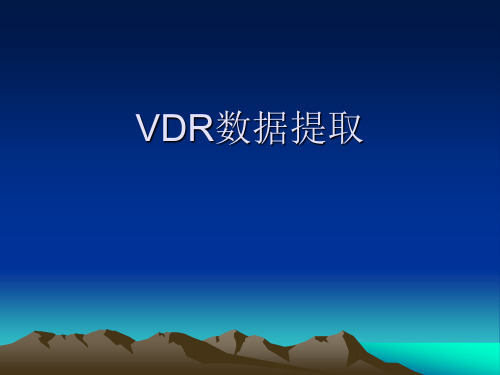
对下沉式保护容器,取消了抗穿刺要求 对上浮式保护容器,取消了1100度/1小时火烧和 260度
/10小时等要求
VDR结构
主机单元
不同形式的黑匣子
数据回放软件
• VDR供应商提供通用USB/Ethernet/FireWire或 等价接口;提供能运行于通用便携机操作系统的 软件及说明书
• 提供最原始、最真实的船舶动态信息和操 作记录,所记录数据的精确性、真实性和 连续性是传统海事调查手段无法做到的;
• 将发生碰撞的两船的VDR所记录的数据再 现于电子海图上,可以真实地反映出碰撞 当时及前后的运动过程;
• 通过模拟仿真技术,更能真实地再现当事 船舶的运动状态及当时的通航环境和海况。
VDR数据提取
VDR(船载航行数据记录仪)
• VDR:Voyage Data Recorder ,简单地 说就是“船舶黑匣子”,用于记录船舶航 行状态数据的专用设备。能够以一种安全 和可恢复的方式,存储船舶发生事故前后 一段时间的与船舶位置、动态、物理状态、 命令和操纵相关的信息。
VDR在海事调查中的作用
(2)对2002年7月1日之前建造的3,000总吨
及以上,但小于20,000总吨的货船,在2007年7
月1日之后第1次计划坞修日,但不晚于2010年7
月1日。
VDR与S-VDR的区别
• 对采集数据的要求有差别
VDR要求采集所有标准上要求的信号(不管是否有标准信 号接口)
S-VDR要求采集重要信号(对一些信号,如果没有标准接口, 则可以不采集,例如雷达图像)
VDR的数据接入
国际海事组织关于安装S-VDR的规定
•
2004年,IMO在SOLAS公约新增第V/20.2
船用数据记录仪VDR介绍
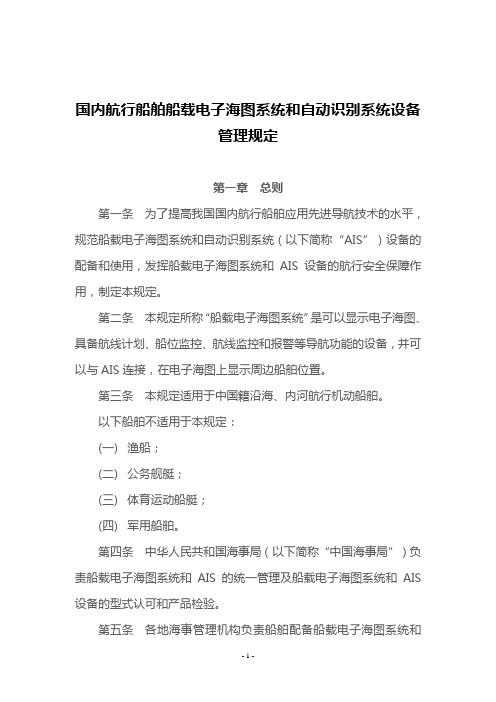
国内航行船舶船载电子海图系统和自动识别系统设备管理规定第一章总则第一条为了提高我国国内航行船舶应用先进导航技术的水平,规范船载电子海图系统和自动识别系统(以下简称“AIS”)设备的配备和使用,发挥船载电子海图系统和AIS设备的航行安全保障作用,制定本规定。
第二条本规定所称“船载电子海图系统”是可以显示电子海图、具备航线计划、船位监控、航线监控和报警等导航功能的设备,并可以与AIS连接,在电子海图上显示周边船舶位臵。
第三条本规定适用于中国籍沿海、内河航行机动船舶。
以下船舶不适用于本规定:(一)渔船;(二)公务舰艇;(三)体育运动船艇;(四)军用船舶。
第四条中华人民共和国海事局(以下简称“中国海事局”)负责船载电子海图系统和AIS的统一管理及船载电子海图系统和AIS设备的型式认可和产品检验。
第五条各地海事管理机构负责船舶配备船载电子海图系统和AIS设备情况实施监督检查。
各船检机构负责设备安装情况的检验。
第二章设备标准及型式认可第六条中国籍国内航行船舶配备的船载电子海图系统设备应符合中国海事局《国内航行船舶船载电子海图系统(ECS)功能、性能和测试要求(暂行)》中的A级设备要求。
中国籍船舶配备的A级AIS应符合国际电工委员会(IEC) 61993-2标准《海上导航和无线电通信设备和系统-自动识别系统(AIS)第二部分:通用自动识别系统(AIS)A级船载设备-操作和性能需求、测试方法和要求的测试结果》,中国籍国内航行船舶配备的B级AIS应符合中国海事局《国内航行船舶船载B级自动识别系统(AIS)设备(SOTDMA)技术要求(暂行)》或国际电工委员会(IEC)62287-1标准《海上航行和通信设备与系统B级船载自动识别系统(AIS)第一部分:载波侦听时分多址技术(CSTCDMA)》。
第七条国内航行船舶配备的船载电子海图系统、AIS设备需经型式认可和产品检验。
第八条经授权的船舶检验机构应按照中国海事局《国内航行船舶船载电子海图系统(ECS)功能、性能和测试要求(暂行)》、《国内航行船舶船载B级自动识别系统(AIS)设备(SOTDMA)技术要求(暂行)》、国际电工委员会(IEC)62287-1标准《海上航行和通信设备与系统B级船载自动识别系统(AIS)第一部分:载波侦听时分多址技术(CSTCDMA)》、国际电工委员会(IEC) 61993-2标准《海上导航和无线电通信设备和系统-自动识别系统(AIS)第二部分:通用自动识别系统(AIS)A级船载设备-操作和性能需求、测试方法和要求的测试结果》分别对船载电子海图系统、A级和B级AIS设备进行型式认可和产品检验。
航行安全篇之--航行数据记录仪(VDR)

航行安全篇之--航行数据记录仪(VDR)船载航行数据记录仪(即Voyage Data Recorder,简称VDR,又名船用黑匣子)是一种实时记录并保存船舶发生事故前后船体有关信息的仪器。
根据性能标准分为VDR和S-VDR(简化航行数据记录仪),下面小编带你详细了解一下船载VDR和S-VDR的配备与性能标准的“前世今生”。
一VDR主要构成二VDR公约要求船舶配备要求VDR:所有客船或客滚船和2002年7月1日及以后安放龙骨的3000总吨及以上的非客船。
参见:SOLAS公约修正案(MSC.99(73))第V章第20条。
VDR/S-VDR:2002年7月1日以前安放龙骨的3000总吨及以上的货船。
参见:SOLAS公约修正案(MSC.170(79))第V章第20条。
*免除安装:除客滚船外,对于2002年7月1日以前建造的船舶,如果证明VDR与船上的现有设备连接为不合理和不可行,主管机关可以对其免除配备VDR的要求。
(一般没有)年度性能测试要求SOLAS公约第V章第18.8条要求船载VDR系统及所有传感器应进行年度性能测试(Annual Performance Test),测试应由经认可的机构进行,船上应保留一份由测试机构颁发的载明符合日期和使用性能标准的符合证书副本。
技术性能发展与变化随着航海技术的发展,VDR设备性能标准发生了四次变化,相对应的决议分别为 A.861(20)、MSC.163(78)、MSC.214(81)和MSC.333(90),以上决议案均被SOLAS公约引用并具有强制性。
A.861(20)是IMO大会1997年11月27日通过的船载航行数据记录仪(VDR)性能标准,SOLAS公约2000修正案引入配置要求;适用于2008年6月1日以前安装的VDR。
MSC.163(78)是海安会2004年5月17日通过的船载简化航行数据记录仪(S-VDR)性能标准,同年12月份SOLAS修正案引入S-VDR配置要求;适用于2008年6月1日以前安装的S-VDR。
(完整版)VDR船舶黑匣子

船载航行数据记录仪(VDR)介绍船载航行数据记录仪(VOYAGE DATA RECORDER缩写VDR)是一种船舶安全监控产品,主要用于实时采集、记录船舶航行过程中各种静态、动态航行数据,并将最新一段时期的数据保存于最终存储器,该存储器在船舶失事后有较大的生存可能性,以便打捞出来后,在特定的VDR数据再现设备真实再现船舶发生重大海难或受损前后一段时间内船舶航行状态、驾控人员操作处理情况以作为事故调查,判断事故发生原因的重要依据和处理海事纠纷的重要证据。
其功能相当于飞机上的黑匣子,因而也有人将VDR 称为“船用黑匣子”。
它与飞机黑匣子、汽车黑匣子等同属于电子信息类的安全事件取证和证据保全类产品。
2000年12月国际海事组织(IMO)通过A.861(20)号决议案,要求国际航行及沿海航行船舶均应安装船载航行数据记录仪(VDR)。
国际海事组织第20次大会(1997年11月27日)通过了《船载航行资料记录仪(VDR)性能标准》A.861(20)号决议。
《船载航行资料记录仪(VDR)性能标准》的附件《船载航行资料记录仪(VDR)性能标准建议案》是建议船用黑匣子的最低标准,主要内容有:1. 船用黑匣子是一个完整的系统,包括资料处理,编码,资料介面,记录介质,电源供应和专用备用电源(可充电式VDR辅助电池)和相关项目。
2. 应能连续记录在事故发生期间的有关活动,当船电中断时船舶的应急电源应能供电,当应急电源中断时专用备用电源应供电2 小时。
3. 能记录日期,时间,船位,速度,艏向,驾驶室声音,通信声音,雷达资料和显示后的选择,测深仪,主报警,操舵命令和回应,轮机命令和回应,船体破口状况,水密和防火门状况,横摇和船体应力,风速和风向等。
4. 要求在正常工作状态下应是完全自动的。
能在事故后保存记录资料并恢复和再现这些资料。
与船舶任何设备的连接,都不应妨碍该设备的正常工作,即使船用黑匣子系统出现故障时。
国际海事组织对安装船用黑匣子的建议时间国际海事组织海上安全委员会第72次会议(2000年5月17-26日),决定同意对国际间航行的滚装船和客运船上安装VDR的最后期限;第73次会议(2000年11月27日-12月6日)对各种船舶安装船用黑匣子的建议时间期限为:2002年7月1日及以后建造的客轮;2002年7月1日及以前建造的滚装客船在不晚于2002年7月1日以后的首次检时;2002年7月1日及以后建造除滚装客船以外的客轮不晚于2004年1月1日;2002年7月1日及以后建造的,除旅客轮船以外3000总吨及以上轮船.Ships' “black boxes” and automatic identification systems – regulations enter into force on 1 July 2002New regulations for certain size ships to carry voyage data recorders (VDRs) and automatic identification systems (AISs) enter into force today (1 July 2002).The mandatory regulations are among a raft of amendments to the International Convention for the Safety of Life at Sea, 1974 (SOLAS) entering into force on 1 July 2002. In addition, under its second phase of implementation, the International Management Code for the Safe Operation of Ships and for Pollution Prevention (ISM Code) becomes mandatory for most ships trading internationally on 1 July 2002.The revised SOLAS chapter V (Safety of Navigation), which was adopted in December 2000, includes a number of important new requirements for ships, including those relating to carriage of VDRs and AIS and acceptance of electronic charts as meeting the chart carriage requirements.Voyage data recordersLike the black boxes carried on aircraft, VDRs enable accident investigators to review procedures and instructions in the moments before an incident and help to identify the cause of any accident. Performance standards for VDRs were adopted by IMO in 1997 (IMO resolution A.861(20)) and IMO encourages all ships to carry VDRs.In addition, IMO’s Maritime Safety Committee (MSC) in May 2002 approved MSC/Circ.1024 on Guidelines on Voyage Data Recorders (VDR) ownership to complement the VDR performance standards.VDR requirementsThe following ships are required to carry VDRs, under regulation 20 of the new SOLAS Chapter V:passenger ships constructed on or after 1 July 2002;ro-ro passenger ships constructed before 1 July 2002 not later than the first survey on or after 1 July 2002; passenger ships other than ro-ro passenger ships constructed before 1 July 2002 not later than 1 January 2004; and ships, other than passenger ships, of 3,000 gross tonnage and upwards constructed on or after 1 July 2002.VDRs are required to meet performance standards “not inferior to those adopted by the Organization”. Performance standards for VDRs were adopted in 1997 and give details on data to be recorded and VDR specifications. They state that the VDR should continuously maintain sequential records of preselected data items relating to status and output of the ship's equipment and command and control of the ship. The VDR should be installed in a protective capsule (太空舱) that is brightly coloured and fitted with an appropriate device to aid location. It should be entirely automatic in normal operation. Under the new regulation, the voyage data recorder system, including all sensors, shall be subjected to an annual performance test conducted by an approved testing or servicing facility to verify the accuracy, duration and recoverability of the recorded data.Administrations may exempt ships, other than ro-ro passenger ships, constructed before 1 July 2002, from being fitted with a VDR where it can be demonstrated that interfacing a VDR with the existing equipment on the ship is unreasonable and impracticable.VDRs for existing cargo shipsIn December 2000, IMO’s Maritime Safety Committee (MSC) adopted a resolution on the carriage of VDRs on existing cargo ships, which calls for a feasibility study (可行性研究)to be carried out to ascertain the need for mandatory carriage of VDRs on these ships. The feasibility study, being conducted by the Sub-Committee on Safety of Navigation (and other Sub-Committees as appropriate), takes into account such factors as practicability, technical problems relating to the retrofitting (花样翻新)of VDRs, adequacy of existing performance standards including the possible development of simplified standards, experience in the use of VDRs on ships already fitted with them, including data that could not have been obtained without VDRs, and relevant financial implications, including a cost-benefit analysis.The aim is to finalize the study by 1 January 2004 so that, if the study demonstrates a compelling (强制的)need for mandatory carriage of VDRs on existing cargo ships, relevant amendments to SOLAS Chapter V and the associated performance standards can be drafted. In the meantime, the resolution invites Governments toencourage shipowners to install VDRs on existing cargo ships voluntarily, so that wide experience of their use may be gained.IMO GUIDELINES ON VOYAGE DATA RECORDERS (VDR) OWNERSHIP AND RECOVERY1.) Ownership of VDR/data:The ship owner will, in all circumstances and at all times, own the VDR and its data. however, in the event of an accident the following guidelines would apply.2.) Recovery of VDR:Recovery of the VDR is conditional on the accessibility of the VDR or the data contained therein.a.) In the case of a non-catastrophic (灾难的)accident, recovery of the memory should bestraightforward. For example, in some VDRs it can be accomplished by removal of a hard discfrom the VDR unit. This action will have to be taken soon after the accident to best preserve therelevant evidence for use by both the investigator and the ship owner. As the investigator is veryunlikely to be in a position to instigate this action soon enough after the accident, the owner mustbe responsible, through its on-board standing orders, for ensuring the timely preservation of thisevidence in this circumstance.b.) In the case of abandonment of a vessel during an emergency, masters should, where time andother responsibilities permit, recover the memory and remove it to a place of safety and preserveit until it can be passed to the investigator.c.) In the case of a catastrophic accident, where the VDR is inaccessible and the data has notbeen retrieved prior to abandonment, a decision will need to be taken by the Flag State in co-operation with any other substantially (充分的)interested States on the viability (生存能力)and cost of recovering the VDR balanced against the potential use of the information. If it isdecided to recover the VDR the investigator should be responsible for co-ordinating its recovery.The possibility of the capsule having sustained damage must be considered and specialistexpertise will be required to ensure the best chance of recovering and preserving the evidence. Inaddition the assistance and co-operation of the owners, insurers and the manufacturers of theVDR and those of the protective capsule may be required.3.) Custody (保管)of VDR/data:In all circumstances, during the course of an investigation, the investigator should have custody of the original VDR data, perhaps in the form of the whole or part(s) of the VDR itself, in the same way as if he has custody of other records or evidence under the Code for the Investigation of Marine Casualties and Incidents.4.) Read-out of VDR/data:In all circumstances the responsibility to arrange down loading and read-out of the data from the recovered memory in whatever form should, in the first instance, be undertaken by the investigator who should keep the shipowner fully informed. Additionally, specially in the case of a catastrophic accident where the memory may have sustained damage, the assistance of specialist expertise may be required to ensure the best chance of success.5.) Access to the data:Although the investigator will have custody of the original VDR memory in whatever form for the duration of the investigation, a copy of the data must be provided to the ship owner at an early stage in all circumstances. Further access to the data will be governed by the applicable domestic legislation of the flag state, coastal state and the lead investigating state as appropriate and the guidelines given in the Code for the Investigation of Marine Casualties and Incidents.Data items to be recorded。
船舶VDR与SVDR的区别及数据提取
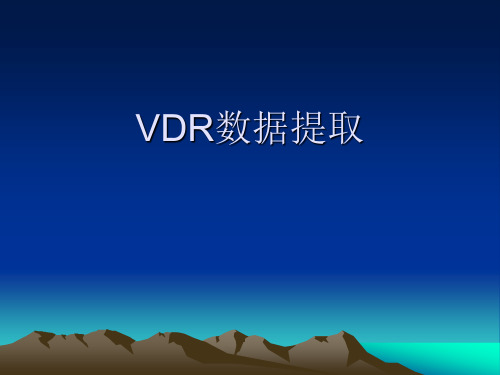
XX 轮 VDR
• XX轮VDR
VDR的数据接入
国际海事组织关于安装S-VDR的规定
• 2004年,IMO在SOLAS公约新增第V/20.2 条–航行数据记录仪中,要求从事国际航行的现有 货船按下述时间表配备简易VDR,即S-VDR: (1)对2002年7月1日之前建造的20,000总 吨及以上货船,在2006年7月1日之后第1次计划 坞修日,但不晚于2009年7月1日; (2)对2002年7月1日之前建造的3,000总吨 及以上,但小于20,000总吨的货船,在2007年7 月1日之后第1次计划坞修日,但不晚于2010年7 月1日。
Hale Waihona Puke VDR数据提取VDR(船载航行数据记录仪)
• VDR:Voyage Data Recorder ,简单地 说就是“船舶黑匣子”,用于记录船舶航 行状态数据的专用设备。能够以一种安全 和可恢复的方式,存储船舶发生事故前后 一段时间的与船舶位置、动态、物理状态、 命令和操纵相关的信息。
VDR在海事调查中的作用
VDR与S-VDR的区别
• 对采集数据的要求有差别
VDR要求采集所有标准上要求的信号(不管是否有标准信 号接口) S-VDR要求采集重要信号(对一些信号,如果没有标准接口, 则可以不采集,例如雷达图像)
• 对数据保护容器的要求有差别
对下沉式保护容器,取消了抗穿刺要求 对上浮式保护容器,取消了1100度/1小时火烧和 260度 /10小时等要求
国际海事组织关于安装VDR的规定
• 从事国际航行的船舶要求按照下列时间表安装航 行数据记录仪: (1)在2002年7月1日及以后建造的客船; (2)客滚轮不迟于2002年7月1日之后的第 一次检验; (3)除客滚轮之外的客船不迟于2004年7月 1日; (4)在2002年7月1日及以后建造的除客船 以外的3000总吨及以上的所有船舶。
VDR
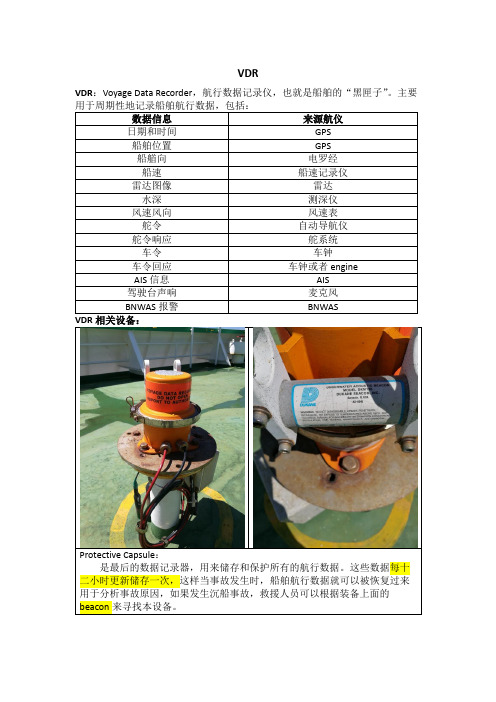
VDRVDR:Voyage Data Recorder,航行数据记录仪,也就是船舶的“黑匣子”。
主要Protective Capsule:数字是0的话就是Serial Isolated Converter出了故障),模拟警报analog alarm(警报ID以U开头,如果最后一个数字是0,则表示应该是analog card 的问题),数字警报digital alarm(以D开头,意思是digitalinput/output card,以X开头,意思是digital inputcard;如果最后一个数字是0,就是digital card的问题了)(大多数情况下,VDR的alarm都类似于误报警,可能是温度太高船舶摇等原因,在ACKALARM后,alarm自己就会恢复)VIDEO:点击video,即可查看当前雷达图像,点击zoom in/out,还可以调节图像大小。
由于本船VDR 只连接了2号X-band雷达,所以只能看到2号雷达的图像。
SHIP INFO:点击,就可以查看船舶基础信息,包括船级社,时间日期,位置,船速,船艏向,水深,风和舵。
FUNCTION:有两个选项,service mode和data backup。
Data backup里包括Long-term data backup和Manual data backup。
Long-term data backup是长期储存,就在系统里,可以存储duoda30天的内容,如果储存的内容超过存储容量,系统会自动覆盖更新。
Manual data back ,可以将系统内储存的内容复制出来,还可以自己选择要备份到的地方,备份数据的类型和时间间隔1.将准备好的外置储存设备通过USB与VDR连接2.在VDR屏幕上点击FUNCTION3.选择MANUAL DATA BACK,然后点击NEST4.点击BROWSE5.选择好DATA TYPE和PERIOD6.最后OK就行了VDR start up步骤:1.turn on the“MAIN”和“BATTERY”2.按顺序依次turn on the“I/O”,“SVIU”,“SIC16”,“SAIU”,“CAPSULE”,“ROMU”一般情况下通常power on5分钟后才会start upI/OCAPSULE ROMU SAIU SIC16 SVIUShut down步骤:1.按住“OFF”五秒。
航海仪器演示文稿
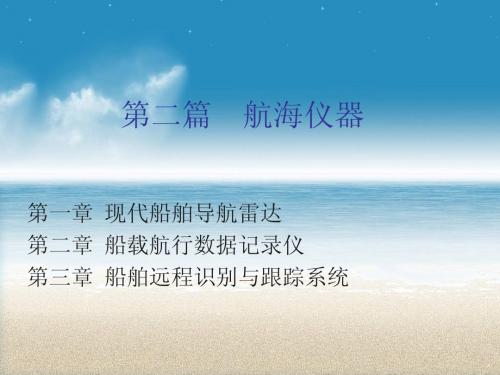
• 船载航行数据仪配备要求
船舶种类|建造时间 客船或客滚船 3000总吨以上货船 2002-7-1 之后建造 VDR VDR 2002-7-1 之前建造 VDR VDR 或 S-VDR
船载航行数据记录仪的组成:
• • • • 数据处理器 麦克风组 传感器接口及信号处理器 数据保护舱 –保存记录2年以上 –保护舱水下声响信标电池应能供电30天以上 • 报警指示器 • 电源 –双套电源:主电源和应急电源 –备有UPS保护装置,可提供电源2小时以上 • 数据回放设备
LRIT系统的基本工作原理
通信服务提供商 (CSP)
•
通信服务提供商(CSPs) 使用通信协议提供连接 LRIT系统各个部分的服 务,以确保各终端安全 传输LRIT信息 – 船载设备应使用能 够覆盖船舶所有操 作区域的通信系统 进行LRIT信息的发 送 – CSP也可以作为应 用服务提供商( ASP)提供服务
第一节 现代船舶导航雷达的基本配置
GN33-提供船位 和时间基础数据
AIS
电罗经/THD(艏向发送 器)-提供船舶航向数据
雷 达
VDR-航程 数据记录仪
SDME(速度和航程设 备)提供船舶速度 ECDIS
第二节
现代船舶导航雷达使用性能
雷达的观测性能 雷达的发射能力 雷达的测量精度 雷达的探测性能 目标发现能力 探测距离和分辨率 抗杂波干扰能力 数据处理能力 雷达的操控性能 雷达的避碰性能 ① 目标探测 ② 目标尾迹,过去位置 ③ 雷达跟踪目标能力 ④ AIS报告目标 ⑤ 跟踪目标和报告目标关联 ⑥ 目标报警 ⑦ 试操船等 雷达的导航性能
第二节 船载航行数据记录仪的操作,检验与管理
船载航行数据记录仪操作
• • • 驾驶员对VDR/S-VDR的正常运行负有管理责任,负责保证系统正常运行 ,对设备的相关报警及处理结果应在航行日志或相关的设备记录簿中予以 详细记录。 配置操作 运行操作 1. 操作控钮的基本操作
VDR课件
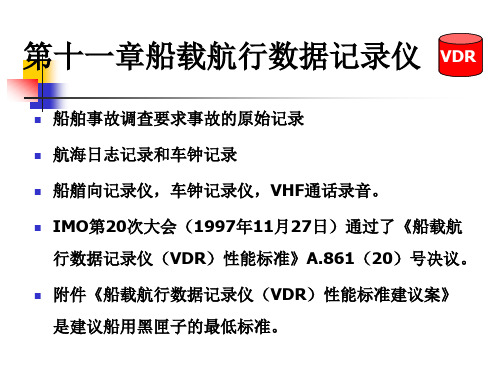
(11)船舶总吨位 (12)船舶净吨
(GROSS TONNAGE) (NET TONNAGE)
(13)NE)
(NUMBER OF MAIN ENGINE)
(15)主机转速
(16)推进器种类
(REVOLUTIONES OF MAIN ENGINE)
1)船舶动态信息
日期和时间/GPS 船舶的航行速度/Speed log 自动操舵信息Steering/autopilot 主机螺旋桨轴转速Engine 转舵操作Steering/autopilot 风速向测试仪信息/Wind indicator 主雷达视频/Radar 船体应力和响应/Hull stress system 船舶位置/GPS 船舶航向/Gyro 主机转速/Engine telegraph 实际舵角/Steering/autopilot 声纳探测仪相关信息/Echo sounder 船舶俯仰、倾斜角度状态 水密和防火门状况/Door indication 船体开口状况/Door indication
(KIND OF PROPELLERS)
(17)所有人名称和地址 (NAME AND ADDRESS OF
REGISTERED SHIPOWNER) (18)管理人/经营人名称和地址 (NAME AND ADDRESS OF SHIP MANAGER/OPERATER)
(2) VDR动态信息和操作信息数据
用。允许将数据记录和显示,产生数据库,供模拟、培训或维护。
(1) VDR固定数据:固化在记录仪长期保存,并备份 在黑匣子中。可用再现回放装置读出,不能随意变 更和改动
(1)船舶名称 NAME OF SHIP
(2)船舶国际编码
(3)船舶呼号 (4)登记号码 (5)船舶种类 (6)船籍港
第十一章航行数据记录仪
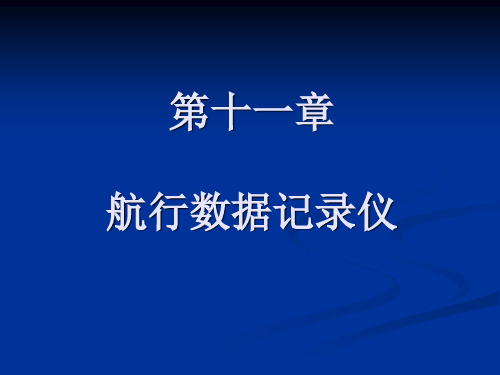
二、VDR的技术指标
1. 记录数据的存储和记录要求 2. VDR信息数据的最终介质存储容量(时间) 3. VDR环境条件和工作条件 (1)环境温度 (2)倾斜摇摆 (3)湿度 4. VDR的适应性 (1) VDR的适应性 (2)记录在黑匣子内的数据的适应性
三、VDR的扩展功能
1. 船载航行监控系统 2. VDR数据回放设备 3. 船舶航行管理网络
第十一章
航行数据记录仪
第一节 VDR概述
航行数据记录仪(voyage data recorder, VDR )是一种专门用于记录和保存船舶航 行过程中重பைடு நூலகம்信息参数的智能化记录设备。
一、VDR的使用意义
二、AIS、VDR和ECDIS的关系
三、船舶黑匣子
四、VDR发展方向——实时传输系统
五、系统组成
第三节 VDR的配备要求和相关法规
一、VDR的安装期限 二、VDR管理 三、VDR安装 四、VDR在还是取证中应注意的问题
1. 主机 2. 数据采集模块 3. 语音模块 4. 雷达图像采集模块 5. 主存储器 6. 黑匣子备份存储器 7. 备用电源
第二节 VDR的主要功能及技术指标
一、VDR的主要功能 1. 记录功能 (1)VDR的船舶固定数据 (2)VDR的船舶动态信息和操作信息数据 (3)雷达图像 (4)语音信息 2. 显示和打印功能 3. 自检功能 4. 自动报警
船载航行数据记录仪
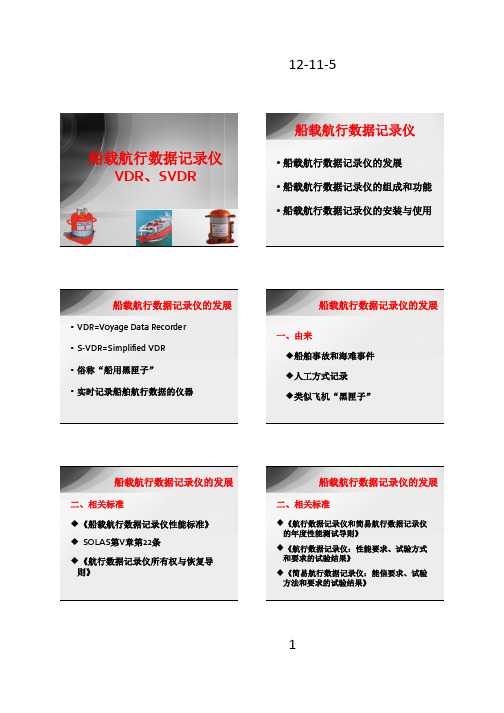
u 在船舶正常营运时,通过标准操作 程序应不能访问最终记录介质
u 提供一种措施,在不打开保护容器 的情况下,通过外部装置恢复存贮 的信息
船载航行数据记录仪的组成和功能
一、系统组成
u 保护存储单元
u 安装在船舶的外部甲板 u 冲击、穿刺、耐火、深海压力和潜水 u 外壳高可见度的发荧光的橙色 u 标识“VOYAGE DATA RECORDER-‐DO
船载航行数据记录仪安装与使用
三、发生事故后的操作
u 当船舶因事故需要弃船时,若情况允许, 船长或指定人员应尽量将数据备份至移动 存储介质并带走;若情况紧急,则可无需 任何操作,设备在断电2h后,将自动停止 数据记录,记录的数据将随保护存储单元 回收后得到恢复。
u 以上操作均匀记录《航海日志》中。
u 数据处理器、传感器接口及信号处 理电路
船载航行数据记录仪的组成和功能
一、系统组成
u 数据采集单元
u 数据处理器RS232接口或RS422接口
u 数据精度取决于设备输出的数据精度
u 可移动的存储介质(flash memory)
u 俗称“白匣子”
u 电源开关操作 u 设在主机不易被接触或被锁定的位置 u 启动时应注意电源开关接通顺序 u 电源接通后,应查看警报指示单元
船载航行数据记录仪安装与使用
二、日常操作
u 存储操作
u 有的存储按钮可将近12h记录存储在FRM
u 有的随时将数据备份至FRM,存储按钮终 止备份
三、发生事故后的操作
u 在船舶发生一般性事故后,船长或指定人 员应将按设备操作说明书,将数据备份至 移动存储介质,并复制至计算机,检查数 据的有效性。
关于船(艇)载航行数据记录仪数据仪的研究
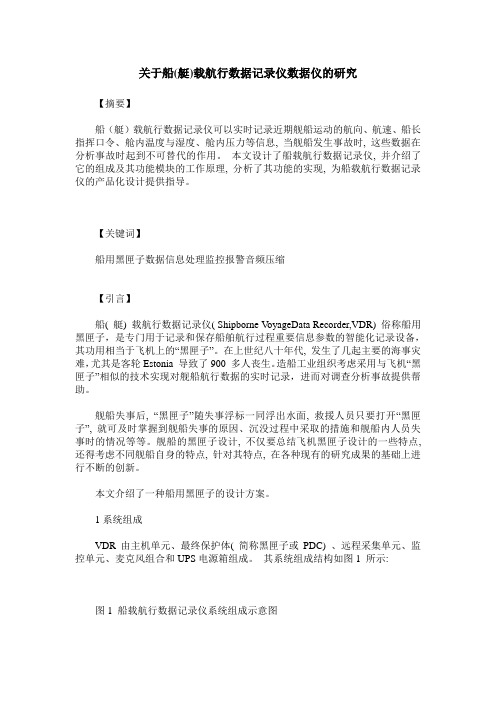
关于船(艇)载航行数据记录仪数据仪的研究【摘要】船(艇)载航行数据记录仪可以实时记录近期舰船运动的航向、航速、船长指挥口令、舱内温度与湿度、舱内压力等信息, 当舰船发生事故时, 这些数据在分析事故时起到不可替代的作用。
本文设计了船载航行数据记录仪, 并介绍了它的组成及其功能模块的工作原理, 分析了其功能的实现, 为船载航行数据记录仪的产品化设计提供指导。
【关键词】船用黑匣子数据信息处理监控报警音频压缩【引言】船( 艇) 载航行数据记录仪( Shipborne V oyageData Recorder,VDR) 俗称船用黑匣子,是专门用于记录和保存船舶航行过程重要信息参数的智能化记录设备,其功用相当于飞机上的“黑匣子”。
在上世纪八十年代, 发生了几起主要的海事灾难,尤其是客轮Estonia 导致了900 多人丧生。
造船工业组织考虑采用与飞机“黑匣子”相似的技术实现对舰船航行数据的实时记录,进而对调查分析事故提供帮助。
舰船失事后, “黑匣子”随失事浮标一同浮出水面, 救援人员只要打开“黑匣子”, 就可及时掌握到舰船失事的原因、沉没过程中采取的措施和舰船内人员失事时的情况等等。
舰船的黑匣子设计, 不仅要总结飞机黑匣子设计的一些特点, 还得考虑不同舰船自身的特点, 针对其特点, 在各种现有的研究成果的基础上进行不断的创新。
本文介绍了一种船用黑匣子的设计方案。
1系统组成VDR由主机单元、最终保护体( 简称黑匣子或PDC) 、远程采集单元、监控单元、麦克风组合和UPS电源箱组成。
其系统组成结构如图1 所示: 图1 船载航行数据记录仪系统组成示意图2基本原理航行状态记录器的功能是由硬件和软件共同完成的。
它通过CAN2.0B总线接口和其它输入接口接收船舶导航系统、主动力系统、电力系统和监控系统中以模拟量、开关量和数字量等重要参数信息, 并按照接收的时间顺序依次存储在非易失性介质中。
以“先进先出”的原则自动丢弃前面的数据, 记录新的数据, 从而始终保存最近时间内(具体存储时间以实际情况为准)的数据。
船舶VDR与SVDR的区别及数据提取

• VDR:Voyage Data Recorder ,简单地 说就是“船舶黑匣子”,用于记录船舶航 行状态数据的专用设备。能够以一种安全 和可恢复的方式,存储船舶发生事故前后 一段时间的与船舶位置、动态、物理状态、 命令和操纵相关的信息。
VDR在海事调查中的作用
VDR的数据接入
国际海事组织关于安装S-VDR的规定
• 2004年,IMO在SOLAS公约新增第V/20.2 条–航行数据记录仪中,要求从事国际航行的现有 货船按下述时间表配备简易VDR,即S-VDR: (1)对2002年7月1日之前建造的20,000总 吨及以上货船,在2006年7月1日之后第1次计划 坞修日,但不晚于2009年7月1日; (2)对2002年7月1日之前建造的3,000总吨 及以上,但小于20,000总吨的货船,在2007年7 月1日之后第1次计划坞修日,但不晚于2010年7 月1日。
XX 轮 VDR
• XX轮VDR
国际海事组织关于安装VDR的规定
• 从事国际航行的船舶要求按照下列时间表安装航 行数据记录仪: (1)在2002年7月1日及以后建造的客船; (2)客滚轮不迟于2002年7月1日之后的第 一次检验; (3)除客滚轮之外的客船不迟于2004年7月 1日; (4)在2002年7月1日及以后建造的除客船 以外的3000总吨及以上的所有船舶。
VDR结构
主机单元
不同形式的黑匣子
数据回放软件
船载航行数据记录仪(VDR)详解PPT精选文档

1、国际贸易的发展,海上运输业的膨胀,船舶向着大型 化、快速化发展,一旦有海难事故发生,不仅对生命财产 造成很大的损失,而且对生态和海洋环境造成灾难性的不 可恢复后果。
2、海难事故使IMO面临巨大公众压力; 3、船舶遇险后需要客观证据解释原因; 4、其他交通工具已经在使用类似的设备: 5、包括飞机、汽车、火车等交通工具都先后配备了黑匣
对2002年7月1日之前建造的20,000总吨及以 上货船,在2006年7月1日之后第一次计划坞 修日,但不晚于2009年7月1日;
对2002年7月1日之前建造的3,000总吨及以 上但小于20,000总吨的货船,在2007年7月1 日之后第1次计划坞修日,但不晚于2010年7 月1日。
该修正案已于2006年7月1日生效。
30
三、VDR(S-VDR)数据采集方式
从“白匣子”采集:以太网、USB、 FIREWIRE
从“黑匣子”采集:
31
32
33
获得VDR数据播放软件的方法
要求船方提供; 要求船公司提供; 向VDR生产厂家、安装单位索取; 注意平时收集、积累。
34
15
SVDR和VDR采集信号的差别
16
SVDR和VDR 的数据保护容器差别
对采集数据的要求有差别
– VDR要求采集所有标准上要求的信号(不管是否有 标准信号接口)
– S-VDR要求采集重要信号(对一些信号,如果没有标 准接口,则可以不采集)
对数据保护容器的要求有差别
– 对下沉式保护容器,取消了抗穿刺要求 – 对上浮式保护容器,取消了1100度/1小时火烧和
260度/10小时等要求
17
VDR的性能要求
❖能连续实时地记录在事故发生前后的有关船舶的位置、动 态、命令和操作等信息,能在事故后恢复和再现这些数据
- 1、下载文档前请自行甄别文档内容的完整性,平台不提供额外的编辑、内容补充、找答案等附加服务。
- 2、"仅部分预览"的文档,不可在线预览部分如存在完整性等问题,可反馈申请退款(可完整预览的文档不适用该条件!)。
- 3、如文档侵犯您的权益,请联系客服反馈,我们会尽快为您处理(人工客服工作时间:9:00-18:30)。
VDR产生的过程
– 2000年6月,国际电工委员会 通过了船载航行数据记录仪 的产品标准-------即 IEC61996标准。
6
IMO对VDR的安装要求(Solas第五章)
1、所有所有2002 年7月1日以后建造的客船;
2、2002年7月1日以前建造的客滚船不晚于2002年7月 1日之后的第一个检验日;
船载航行数据记录仪
1
主要内容
一、VDR简要介绍 二、VDR的证据优势 三、VDR数据提取和回放
2
一、VDR简要介绍
1、VDR:Voyage Data Recorder ,简单地说 就是“船舶黑匣子”,用于记录船舶航行数据、 状态、指令的专用设备。
2、VDR的目的:以一种安全和可恢复的方式, 保持存储船舶发生事故前后一段时间的与船舶 位置、动态、物理状态、命令和操纵相关的信 息。
15
SVDR和VDR采集信号的差别
16
SVDR和VDR 的数据保护容器差别
对采集数据的要求有差别
– VDR要求采集所有标准上要求的信号(不管是否有 标准信号接口)
– S-VDR要求采集重要信号(对一些信号,如果没有标 准接口,则可以不采集)
对数据保护容器的要求有差别
– 对下沉式保护容器,取消了抗穿刺要求 – 对上浮式保护容器,取消了1100度/1小时火烧和
18 确保有关数据在恶劣环境下不会丢失
VDR的组成
VDR系统与S-VDR系统在组成上没有太大的 差别,一般由信号提取装置和传感器、最终 记录介质(包括主存储器和备份存储器)、 回放设备、专用备用电源等部分组成。
与调查相关的部分主要有:移动存储模块 (硬盘,即“白匣子”)、最终存储单元 (即“黑匣子”)和回放软件。
3
一、VDR简要介绍
3、VDR产生的背景
1、国际贸易的发展,海上运输业的膨胀,船舶向着大型 化、快速化发展,一旦有海难事故发生,不仅对生命财产 造成很大的损失,而且对生态和海洋环境造成灾难性的不 可恢复后果。
2、海难事故使IMO面临巨大公众压力; 3、船舶遇险后需要客观证据解释原因; 4、其他交通工具已经在使用类似的设备: 5、包括飞机、汽车、火车等交通工具都先后配备了黑匣
国际电工委员会,在2004年底通过了关于简易型航行 数据记录仪的产品标准(草案)IEC PAS 61996-2;
2004年12月,79次海安会通过了经修正的《1974年 国际海上人命安全公约》修正案,该决议规定了现有 货船配备简易型航行数据记录仪的日期,即 MSC170(79)决议。
13
IMO对SVDR配备的时间要求
3、2002年7月1日以前建造的客船不晚于2004 年1月1 日;
4、2002年7月1日以后建造的3000总吨以上国际航行 船舶,必须建造时安装。
7
VDR的数据采集
8
VDR的数据采集
螺旋桨
驾驶台声音 通信声音 传感器数据 雷达图象 主报警器
舵令与回答 船舶开口
9
VDR的数据采集(声音数据)
子。
4
一、VDR简要介绍
4、 VDR的立法过程
– 1997年5月28日-6月26日,在国际海事组织海上安 全委员会第68次会上,船用黑匣子标准起草小组接 受了《船载航行数据记录仪(VDR)性能标准建议 案》;
– 1997年11月27日国际海事组织第20次大会通过了 《船载航行数据记录仪VDR性能标准》A.861(20) 号决议。源自Helmsman主雷达
左侧
右侧
海图室
驾驶台中心
电台
设备
10
S-VDR引入的原因
如果完全按照VDR的标准,在航船安装VDR 将有如下问题。
– 信号复杂,导致设备和安装费用高; – 复杂的设备导致安装周期长,安装调试困难。 – 例如,在2004年1月1日以前安装在在航客船(客滚
船)的标准VDR,平均成本超过了8万美元! – 船东提出强烈不满。
11
S-VDR的产生
为缓和船东的不满,同时也满足公众的要求, IMO对于在航货船采取折中方案,既研制SVDR(The Simplified Voyage Data Recorder ),既基本满足船舶记录的要求, 同时费用降低,也满足船东的要求。
12
S-VDR的产生过程
2004年5月第78次海安会,通过了简易型航行数据记 录仪性能标准的决议,即MSC163(78)决议;
260度/10小时等要求
17
VDR的性能要求
❖能连续实时地记录在事故发生前后的有关船舶的位置、动 态、命令和操作等信息,能在事故后恢复和再现这些数据 ❖正常工作状态下完全自动。与船舶任何设备的连接,都不 应妨碍该设备的正常工作 ❖当船电中断时,船舶应急电源应能供电;当应急电源中断 时,专用备用电源能供电2小时 ❖当发生重大沉船事故时,安装在上层甲板的VDR 副机会自 行弹离船体,上浮到海面并便于被寻找 ❖产品要求具有抗压力、抗海水腐蚀、抗高温的性能,从而
14
SVDR和VDR的差别
1、对采集信号的要求有差别
– VDR要求采集所有标准上要求的信号(不管是否有 标准信号接口);
– S-VDR要求采集重要信号(对一些信号,如果没有标 准接口,则可以不采集;
2、对数据保护容器的要求有差别
– S-VDR 的(固定式)保护容器不再有抗穿刺要求; – S-VDR可以采用漂浮式保护容器。
26
船舶远程可视管理系统
1、通过F站,可进行双向可视对讲及监控; 2、可进行综合数据传输。
对2002年7月1日之前建造的20,000总吨及以 上货船,在2006年7月1日之后第一次计划坞 修日,但不晚于2009年7月1日;
对2002年7月1日之前建造的3,000总吨及以 上但小于20,000总吨的货船,在2007年7月1 日之后第1次计划坞修日,但不晚于2010年7 月1日。
该修正案已于2006年7月1日生效。
19
VDR的组成
20
S-VDR的组成
21
不同形式的主控单元
22
不同形式的黑匣子
23
不同形式的黑匣子
24
VDR的拓展
25
VDR的拓展
VDR的客户端可以将VDR的数据通过F站等设 备,发送到船公司,可以实现定时发送,操作 方便容易;
获得的数据通过转发,可以使得分公司、个人 均可以了解船上基本信息。
